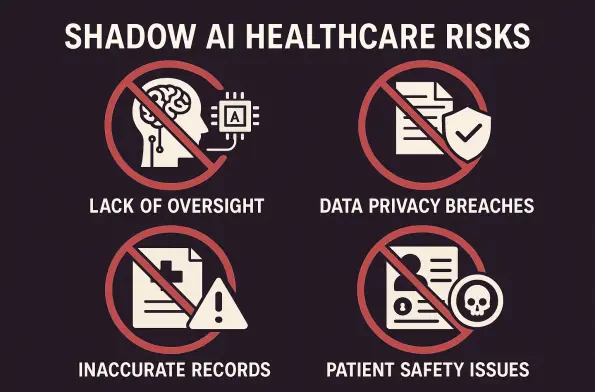In the rapidly evolving landscape of Canadian health care, a silent cyber threat is emerging that could jeopardize the security of sensitive patient data, posing significant risks to privacy and trust. Across hospitals and clinics, doctors and nurses are increasingly turning to public artificial intelligence tools like ChatGPT, Claude, Copilot, and Gemini to streamline tasks such as drafting clinical notes, translating discharge summaries, and summarizing complex patient information. While these tools promise efficiency and ease, they also introduce significant risks by moving confidential health data outside the secure, controlled environments of hospital systems. This unchecked practice, often done with good intentions, bypasses traditional safeguards and exposes vulnerabilities that could have far-reaching consequences. As this trend gains traction, it raises critical questions about privacy, legal compliance, and the readiness of the health-care sector to adapt to new technologies. Understanding and addressing this hidden danger is paramount to protecting both patients and the integrity of Canada’s digital health infrastructure.
1. Unveiling the Rise of Unauthorized AI Use
The adoption of generative AI tools among Canadian health-care professionals is becoming more prevalent, often without formal oversight or approval from institutional authorities. A recent study cited in global health reports reveals that approximately one in five general practitioners in the United Kingdom relies on tools like ChatGPT for drafting clinical correspondence or notes. Although specific data for Canada remains limited, anecdotal evidence suggests a similar pattern is emerging in hospitals and clinics nationwide. This informal use of AI, driven by the need for speed and convenience, reflects a growing dependence on technology to manage overwhelming workloads. However, the absence of structured guidelines means that many clinicians may not fully grasp the implications of using platforms that operate beyond the secure boundaries of health-care networks, potentially compromising patient confidentiality in ways that are difficult to trace or mitigate.
This trend highlights a broader shift in how technology is integrated into daily medical practice, often outpacing the development of corresponding policies. The appeal of public AI tools lies in their accessibility and ability to automate time-consuming tasks, such as summarizing patient histories or translating documents for non-English-speaking individuals. Yet, this convenience comes at a steep cost when sensitive data is processed on foreign servers with unclear security protocols. The lack of Canadian-specific research on this issue only amplifies the uncertainty, leaving health-care facilities vulnerable to breaches that could erode public trust. As more professionals adopt these tools without formal training or authorization, the gap between technological innovation and cybersecurity preparedness widens, creating a pressing need for awareness and intervention to curb potential risks before they escalate into major incidents.
2. Defining the Scope of Shadow AI Risks
Shadow AI, a term used to describe the unauthorized use of AI systems within organizations, poses a unique threat in health-care settings where patient data is highly sensitive. This phenomenon often involves clinicians inputting confidential information into public chatbots or platforms hosted on servers outside secure hospital networks. Once this data leaves a controlled environment, there is no assurance of where it is stored, how long it is retained, or whether it might be repurposed to train commercial AI models. Such practices, though well-intentioned, bypass the rigorous safeguards designed to protect personal health information, creating vulnerabilities that are difficult to detect or address. The silent nature of these data transfers means that breaches can occur without triggering any immediate alarms, leaving organizations unaware of the exposure until significant damage is done.
Beyond the immediate loss of data control, shadow AI represents a growing cybersecurity concern with substantial financial and reputational implications. According to a 2024 IBM Security report, the global average cost of a data breach has reached nearly US$4.9 million, marking a historic high. In Canada, organizations like the Insurance Bureau of Canada and the Canadian Centre for Cyber Security have noted an uptick in internal data leaks caused by unintentional employee actions. Unlike high-profile threats such as ransomware or phishing, shadow AI incidents often stem from human error rather than malicious intent, making them harder to predict or prevent. This blurring of lines between accidental misuse and systemic vulnerability underscores the urgent need for health-care institutions to recognize and address this overlooked threat before it leads to widespread consequences.
3. Limitations of Data Protection Measures
Even when health-care professionals attempt to anonymize patient data before inputting it into public AI tools, the protection offered is often insufficient to prevent re-identification. Research published in Nature Communications demonstrates that seemingly de-identified datasets can be matched to individuals with alarming accuracy when cross-referenced with publicly available information. Clinical details, timestamps, and geographic indicators embedded in the data can collectively paint a detailed picture, undermining efforts to safeguard privacy. This reality challenges the assumption that removing names or hospital numbers is enough to secure information, especially when such data is processed through platforms not designed for health-care confidentiality. The risk of re-identification thus remains a critical concern for Canadian hospitals striving to maintain trust and comply with stringent privacy standards.
Adding to this complexity is the opaque nature of data handling by public AI models like ChatGPT or Claude, which rely on cloud-based systems with ambiguous retention policies. Many of these tools fail to disclose the physical location of their servers or the duration for which data is stored, creating significant legal uncertainties under Canadian regulations such as the Personal Information Protection and Electronic Documents Act (PIPEDA) and provincial privacy laws. For health-care institutions bound by these strict guidelines, the use of unapproved AI tools places them in a legal gray area, where compliance becomes nearly impossible to ensure. This mismatch between existing legislation and modern technology highlights the need for updated frameworks that specifically address the challenges posed by generative AI, ensuring that patient data remains protected regardless of the platforms used for processing.
4. Real-World Examples of Hidden Dangers
Everyday scenarios in Canadian health care reveal how easily shadow AI can compromise patient data without detection. Consider a nurse using an AI-powered online translator to communicate with a non-English-speaking patient. While the translation appears seamless and accurate, the input text—potentially containing diagnoses or test results—is transmitted to servers outside the country, beyond the hospital’s secure network. This seemingly harmless act of improving patient care can inadvertently expose sensitive information to unknown risks, as there is no guarantee of how the data will be handled or stored. Such instances are often driven by a genuine desire to assist, yet they underscore the lack of awareness among staff about the broader implications of using unapproved tools in clinical settings, amplifying the potential for unintended breaches.
Another common example involves physicians leveraging AI platforms to draft follow-up letters or summarize clinical notes, unknowingly placing confidential data at risk. A report from Insurance Business Canada recently warned that shadow AI could emerge as a major blind spot for insurers, given the difficulty in tracking its scope within organizations. Most hospitals lack mechanisms to log or audit AI usage, meaning they cannot determine what information has left their systems or who is responsible for its transmission. This absence of oversight creates a dangerous gap in accountability, where breaches can occur silently and remain undetected until significant harm is done. Addressing this issue requires not only technological solutions but also a cultural shift toward recognizing the hidden risks embedded in routine practices.
5. Bridging the Policy and Practice Divide
Canada’s health-care privacy framework, including laws like PIPEDA and provincial health information acts, was established long before the advent of generative AI, leaving a significant gap in addressing modern technological challenges. These regulations focus on traditional data collection and storage but offer little guidance on machine learning or large-scale text generation. As a result, hospitals must navigate a rapidly evolving digital landscape by interpreting outdated rules, often without clear directives on how to handle AI-related risks. This disconnect between policy and practice creates vulnerabilities in the system, where the informal use of public AI tools can easily slip through the cracks of existing safeguards. The need for updated legislation that explicitly tackles these emerging technologies is evident to ensure that health-care providers can innovate without compromising patient security.
To mitigate the risks associated with shadow AI, cybersecurity experts advocate for a multi-layered approach tailored to the health-care environment. First, routine security audits should include a comprehensive inventory of all AI tools in use, whether officially sanctioned or not, treating generative AI risks similarly to “bring-your-own-device” policies. Second, hospitals should provide certified, privacy-compliant AI platforms that process data within Canadian data centers, allowing for innovation with proper oversight. Third, staff training must emphasize the consequences of entering data into public models, highlighting how even small fragments can breach privacy. These steps aim to align front-line practices with regulatory goals, offering a proactive defense against internal threats. Implementing such measures requires coordinated effort but is essential to safeguard both patient trust and institutional integrity in an increasingly digital health-care landscape.
6. Charting a Secure Path Forward
The Canadian health-care sector faces mounting pressures from staffing shortages, cyberattacks, and growing digital complexity, making the efficiency of generative AI tools an attractive solution for overwhelmed professionals. These tools can automate documentation and translation, easing workloads, but their unchecked use threatens to undermine public confidence in medical data protection. Policymakers are at a crossroads: they must choose between proactively regulating AI integration in health institutions or waiting for a major privacy scandal to force reactive reforms. The stakes are high, as a significant breach could not only compromise patient information but also damage the reputation of the entire health-care system. Balancing the benefits of innovation with the imperative of security remains a critical challenge that demands immediate attention from all stakeholders involved in shaping the future of digital health.
Rather than banning AI tools outright, the focus should shift to their safe integration through robust national standards for “AI-safe” data handling, akin to protocols for food safety or infection control. Such standards would provide clear guidelines for using technology while ensuring patient confidentiality is never compromised. Addressing shadow AI requires a collaborative effort across technology development, policy reform, and staff training to prevent internal cyber threats from escalating. By establishing these frameworks now, Canada can position itself as a leader in secure health-care innovation, protecting sensitive data while harnessing the potential of AI. The time to act is now, before the silent risks embedded in daily clinical routines manifest into crises that could have been avoided with foresight and strategic planning.
7. Reflecting on Proactive Safeguards
Looking back, the integration of shadow AI into Canadian health-care practices revealed a critical vulnerability that had been overlooked for too long. The silent nature of these cyber threats, embedded in routine clinical tasks, posed a real danger to patient privacy and institutional trust. Efforts to address this issue focused on recognizing the prevalence of unauthorized AI use and the limitations of existing data protection measures. Real-world examples demonstrated how easily breaches occurred without detection, while outdated policies struggled to keep pace with technological advancements. The urgency to act was clear, as the risks of inaction far outweighed the challenges of implementing new safeguards. This period underscored the importance of vigilance in adapting to digital tools within sensitive sectors like health care.
Moving forward, the path to security hinged on actionable solutions that balanced innovation with accountability. Establishing national standards for safe AI use emerged as a key step, alongside enhanced training for staff and the provision of privacy-compliant tools. Regular audits to track AI usage provided a mechanism for oversight, ensuring that data remained within secure boundaries. Policymakers and health-care leaders were urged to prioritize these measures, fostering collaboration across sectors to build a resilient digital health infrastructure. By investing in these proactive strategies, the foundation was laid to prevent future breaches, protecting patient confidentiality while embracing the benefits of technology. This commitment to foresight promised to strengthen Canada’s health-care system against hidden threats for years to come.













